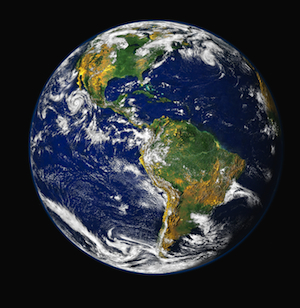Earth OriginIt is believed that the Earth was created by the accretion of cold particles and originally had a homogeneous composition throughout. During the later part of the accretion phase, the Earth was likely heated by kinetic energy of objects colliding with the surface. Combined with the heat generated from radioactive decay of isotopes in the developing earth, the high temperature environment caused the entire planet to melt. Iron was pulled inward toward the core by gravity as lighter minerals - silicon, magnesium and aluminum - migrated upward, cooling to form the Earth's crust about 4.6 billion years ago.
Figure 2.6 Earth, the "Blue Marble" As the planet cooled, solar radiation stripped away its original gasses to be replaced by those trapped beneath the surface and later released by volcanic venting also known as outgassing. The volcanic vapors, like water vapor, vented into the evolving atmosphere and condensed to form clouds, and ice comets appear to have contributed water vapor to the atmosphere. However, the surface was still too hot for water to collect. That which fell to the surface as precipitation quickly vaporized and re-entered the atmosphere to condense once again. As the surface cooled, precipitation finally filled basins and depressions forming the first oceans. The Earth was now on its evolutionary way towards the planet we live on today. The tectonic forces creating the surface configuration of oceans and continents today will be taken up in Chapter 15 "Tectonics and Landforms".
|

